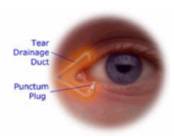 Solutions for Dry Eye
Solutions for Dry Eye
Over 59 million people in the United States suffer from dry eye syndrome, but close to 90% of Americans are unfamiliar with the condition. Dry eye is the term used to describe eyes that either do not produce enough tears or have abnormalities in the tear film composition. Tears are comprised of three layers; an outer oily layer, a middle watery layer, and an inner mucus layer. If the chemical composition of any layer is abnormal, the lubricating properties of the tear film are altered. When the front of the eye becomes dehydrated, nerve endings carry a signal to the glands and cells responsible for tear production. The result is increased tear production. Ironically, one of the symptoms of dry eye is excessive tearing.
 The effects of dry eye vary from person to person, but the most common symptoms experienced are as follows:
The effects of dry eye vary from person to person, but the most common symptoms experienced are as follows:
- irritated, scratchy, uncomfortable eyes
- feeling of a foreign body or “piece of sand” in the eye
- redness, burning
- blurred vision
- excessive tearing or watery eyes
- eyes that lack the normal luster or shine
Dry eye is most often the result of the natural aging process. More than 75% of people aged 65 and older are affected by dry eyes. Women are more commonly affected, in particular during menopause, due to the hormonal changes occurring throughout the body. In addition to age, dry eye can result from any of the following conditions:
- problems with normal blinking (associated with computer use)
- certain medications such as antihistamines for allergies (i.e. Claritin), hormone therapy (i.e. Premarin, birth control), and antidepressants (i.e. Zoloft)
- environmental factors such as dry climate and exposure to wind
- pregnancy
- smoking
- general health problems such as diabetes, acne rosacea, arthritis, Sjogrens syndrome
- contact lens wear
- refractive surgery – LASIK
 Excessive dry eye can damage eye tissue and possibly scar the cornea, the transparent front covering of the eye. Unfortunately, there is no cure for dry eye, but treatments are available to ease the discomfort. Certain lifestyle changes can help to alleviate the symptoms. Decreasing the consumption of caffeine and cigarettes, keeping hydrated by drinking water, using a humidifier at home or work, avoiding wind and dust, and trying to blink more frequently when reading or focusing for an extended period of time may reduce the effects of dry eyes.The first line of treatment is usually the use of artificial tears or lubricant eye drops, which can be purchased over the counter without a prescription. Instilling the drops several times a day or as needed can help people who have mild dryness. Lubricating ointments are also available and can be applied to the eyes at night to help maintain moisture during sleep. The drawback of this therapy is that the effects of artificial tears are generally short-lived, and some people have to use the drops frequently throughout the day to remain comfortable. In this case, the use of drops or ointment is too inconvenient and unacceptable to some people.
Excessive dry eye can damage eye tissue and possibly scar the cornea, the transparent front covering of the eye. Unfortunately, there is no cure for dry eye, but treatments are available to ease the discomfort. Certain lifestyle changes can help to alleviate the symptoms. Decreasing the consumption of caffeine and cigarettes, keeping hydrated by drinking water, using a humidifier at home or work, avoiding wind and dust, and trying to blink more frequently when reading or focusing for an extended period of time may reduce the effects of dry eyes.The first line of treatment is usually the use of artificial tears or lubricant eye drops, which can be purchased over the counter without a prescription. Instilling the drops several times a day or as needed can help people who have mild dryness. Lubricating ointments are also available and can be applied to the eyes at night to help maintain moisture during sleep. The drawback of this therapy is that the effects of artificial tears are generally short-lived, and some people have to use the drops frequently throughout the day to remain comfortable. In this case, the use of drops or ointment is too inconvenient and unacceptable to some people.
 Vitamins can help maintain an adequate tear film. Eye supplements like EyePromise EZ Tears has Omega 3 fatty acids and other nutrients which supports proper tear secretion and tear film health. EyePromise EZ Tears is available at Vision Care Consultants.
Vitamins can help maintain an adequate tear film. Eye supplements like EyePromise EZ Tears has Omega 3 fatty acids and other nutrients which supports proper tear secretion and tear film health. EyePromise EZ Tears is available at Vision Care Consultants.
 A technique called punctal occlusion may reduce or even eliminate the need for lubricating eye drops or ointment. The tears naturally drain out of the eye into the nasal passages through openings in the eyelid called puncta. The puncta are located toward the inner corner of the eye, and there is one punctum on each of the upper and lower eyelids. Medical grade collagen or silicone plugs may be inserted in the puncta to inhibit drainage and keep the tears in contact with the eye for a longer period of time. Usually, punctal plugs are applied to only the lower punctum, but in some cases all four puncta may be blocked. Punctal occlusion is a fairly simple, painless procedure and can be performed in our office. In addition, the plugs may be removed at any time if excessive tearing is produced. In addition to the above treatments, researchers are investigating some alternative treatments with medications like Restasis. Although dry eye is a chronic syndrome and cannot be cured, the current treatments and lifestyle changes do bring relief for the millions of Americans suffering with the symptoms of dryness. Consult one of our doctors at Vision Care Consultants for the latest treatment options appropriate for you.
A technique called punctal occlusion may reduce or even eliminate the need for lubricating eye drops or ointment. The tears naturally drain out of the eye into the nasal passages through openings in the eyelid called puncta. The puncta are located toward the inner corner of the eye, and there is one punctum on each of the upper and lower eyelids. Medical grade collagen or silicone plugs may be inserted in the puncta to inhibit drainage and keep the tears in contact with the eye for a longer period of time. Usually, punctal plugs are applied to only the lower punctum, but in some cases all four puncta may be blocked. Punctal occlusion is a fairly simple, painless procedure and can be performed in our office. In addition, the plugs may be removed at any time if excessive tearing is produced. In addition to the above treatments, researchers are investigating some alternative treatments with medications like Restasis. Although dry eye is a chronic syndrome and cannot be cured, the current treatments and lifestyle changes do bring relief for the millions of Americans suffering with the symptoms of dryness. Consult one of our doctors at Vision Care Consultants for the latest treatment options appropriate for you.
Next, learn about Floaters
